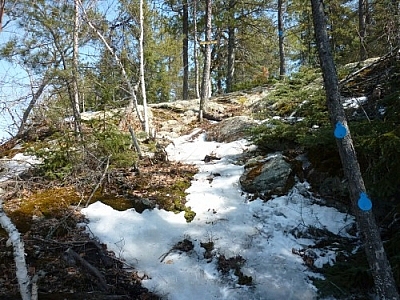As a travel and trekking blogger based in Northern Ontario, the current review of the Ontario Trails Strategy is very important to me. I use trails year-long, mostly for hiking and backpacking, but also for walking, snowshoeing, and canoeing. Were paved trails available in the North to the extent they are in the South, I would dig out my inline skates, too. So I was happy to find out the Ministry of Tourism and Recreation is accepting comments via the Environmental Registry until tomorrow.

I’ve written about trail issues a few times, most notably in:
- New French River Trails Should Post Usage Rules, Safety Guidelines;
- Backcountry Tripping in Mississagi Provincial Park;
- Ontario Closing Provincial Parks, Reducing Ranger Program: Unoperating Parks Under-Served, Day-Based Jobs Inadequate.
These articles point out a few of the issues I discussed in my EBR submission.
Overall, I agree that access to trails for a variety of users must be increased — after all, I use all types of trails — but the importance of maintaining a healthy backcountry trail system shouldn’t be overlooked. Reopening backcountry trails that have been closed down should be a priority.
So should maintaining or increasing funding for trail-related work. It irks me that one of the documents posted to the Environmental Registry, Ontario Trails Strategy [1,300kb PDF], states that “trails attract tourists and tourism creates jobs,” yet only a few paragraphs later, it claims that “Ontario’s trail system was largely built by volunteers.” Job creation should be a result of trail development. Trail building should provide jobs for trail builders.
The onus shouldn’t be on volunteers to develop, build, and maintain trail networks. Many specialised skills and equipment are needed — without these, how does the province expect to build a sustainable trails network? Sustainability is named as a key priority, but volunteers don’t necessarily share a commitment to sustainability when the bottom line and limited time are all that’s in sight. Moreover, the government shouldn’t rely on volunteers to accomplish the work it plans. Dollars need to be budgeted towards job creation in the trail sector itself — not only in the tourism sector.
I also brought up the concern that sustainability and ATV use don’t mix. The vehicles themselves aren’t sustainable, so no plan that allows and/or includes them can be. And of course, they wreak havoc on trails, which then require a lot of expensive maintenance. The risk of injury is greater on trails used by ATVs as the ruts they leave can easily cause twisted ankles or worse, either to people or animals (maybe not to moose, but maybe… but definitely to the horses of equestrians on multi-use trails).
If you’ve got any thoughts on the future direction Ontario’s Trails Strategy should take, you can submit an official public comment online via the Environmental Registry. You can read up on a bit of background info, too, but both documents Ontario Trails Strategy (linked above) and Discussion Paper: Strengthening Ontario’s Trails Strategy [2,800 kb PDF] are about 30 pages long each, so I’m not sure how appealing that sounds. Or you can leave a comment below to start an unofficial discussion (winky face).




Search Niackery
×